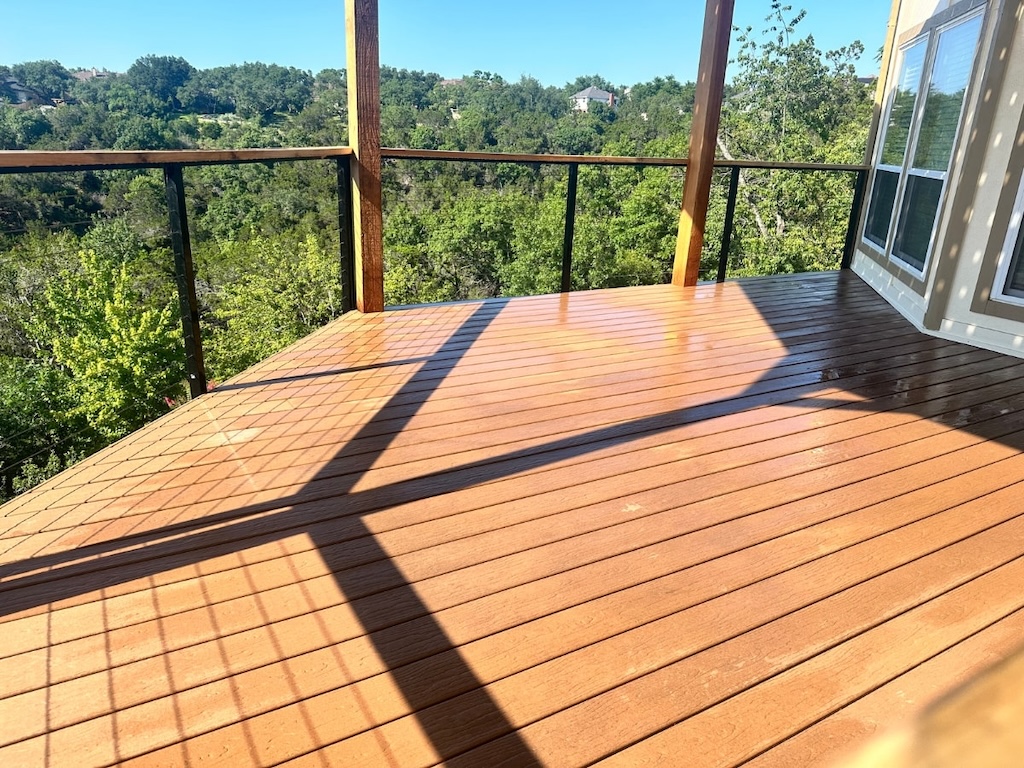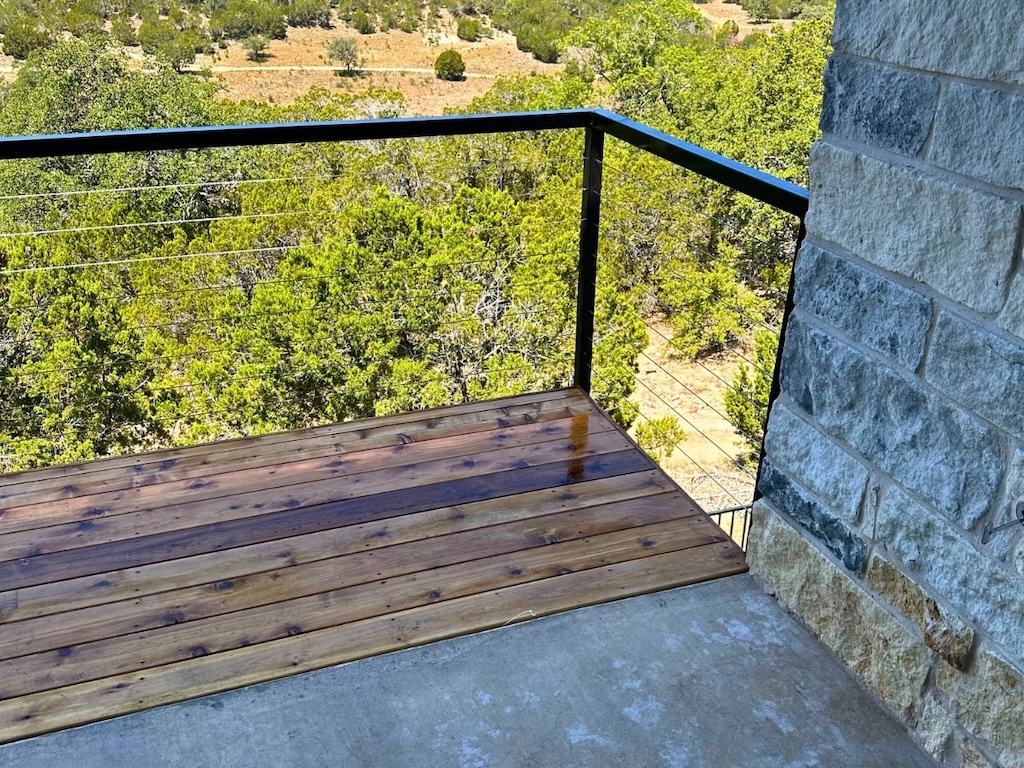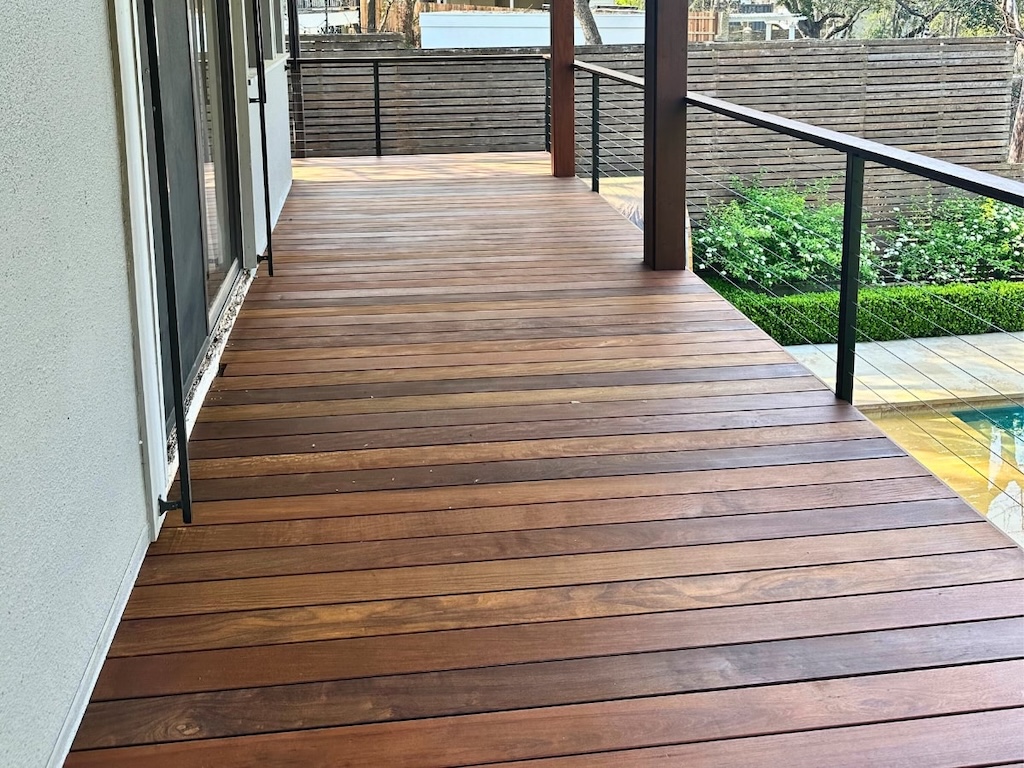TL;DR
“Modern” decks emphasize clean lines, low-maintenance materials, lighter tones, and integrated lighting/shade. “Traditional” decks lean into warm wood textures, classic rail profiles, and ornamental details. In Austin’s heat and UV, modern specs (light-tone composites/PVC, ventilated skirting, compact shade) usually reduce upkeep and feel cooler, making them a key consideration in deck design. traditional specs can win on upfront price and timeless curb appeal if you’ll maintain finishes. The best choice depends on sun exposure, your budget horizon (day one vs. 10 years), and how you’ll use the space. If you want to see what high standards look like locally, browse Ace Deck Builders.
Table of Contents
ToggleAustin Climate 101: Why Style Affects Performance

Two forces dominate Austin deck performance: sun and storm bursts. Dark, dense surfaces heat up; airtight skirting traps warmth and moisture; sudden showers punish poor drainage. “Modern” and “traditional” deck styles aren’t just looks—they steer you toward different materials, colors, and details that live differently in this climate. A modern palette often runs lighter and more matte, with engineered boards that shrug off maintenance; a traditional palette often means stain/seal cycles on cedar or pine and warmer tones that can feel hotter in August. Neither style is “right” on its own; it’s how you execute around Austin physics.
What “Modern” vs. “Traditional” Really Means (Design DNA)
Modern DNA
- Lines & geometry: Long, uninterrupted surfaces; crisp borders; minimal ornamentation.
- Rail profiles: Slim pickets, cable, or low-visual-weight aluminum; caps kept cool with lighter finishes.
- Colors: Light grays, taupes, driftwood, and desaturated earth tones; matte embossing.
- Materials: Capped composite and PVC dominate for color stability and low upkeep.
- Accessories: Subtle step and post lighting; compact pergolas; hidden fasteners; picture-frame borders and divider boards for tidy gaps.
Traditional DNA
- Lines & geometry: Classic rectangles with softened edges; crown or routed accents; sometimes turned posts.
- Rail profiles: Pickets (wood/composite) with recognizable silhouette; chunkier top rails.
- Colors: Natural wood hues—cedar, honey, chestnut—or warmly stained pine.
- Materials: Cedar or pressure-treated pine for that natural grain and underfoot feel; composites in wood-tone shades if maintenance is a concern.
- Accessories: Lantern-style lights, lattice or plank skirting, and benches/planters integrated as trim elements.
Both styles can be executed at a premium or a value level—the difference lies in how they handle heat, water, and wear.
Comfort: Heat, Shade, Surface Feel
Comfort in August is a style-agnostic physics problem:
- Color rules the thermometer. Lighter decks—modern driftwood or traditional light stains—run cooler than dark charcoals or espresso tones.
- Texture matters. Matte, embossed surfaces feel less sticky than shiny caps in peak sun.
- Shade beats almost everything. A small, well-placed pergola over the seating zone creates more usable hours than a brand upgrade spread across the entire deck.
- Rail caps are touchpoints. Keep caps a lighter tone (modern or traditional) to avoid hot-handrail moments.
- Ventilation under low decks keeps surfaces cooler and framing drier in both styles.
Comfort verdict: Modern specs bias you toward light engineered boards and matte textures, which often feel cooler. Traditional cedar can also be comfortable—if you maintain stain color, add a shade plan, and consider built in seating.
Cost: Upfront vs. 10-Year Reality
- Upfront: Traditional wood (pine/cedar) often wins. Classic rails and pickets are cost-effective, and wood is easy to shape on site.
- 10-Year: Engineered boards (standard in modern palettes) reduce stain/seal cycles and keep appearance steady—often cheaper over time. Cable/glass rails (a modern hallmark) are pricier; traditional picket rails are value winners.
Budget lever: If you love modern, get the look with pickets + light-tone composite, reserving cable for one view edge. If you love traditional but hate upkeep, mix cedar accents with a light composite field.
Maintenance: Who Wins Under Real Austin Use
- Traditional wood: Plan for cleaning + staining/sealing every 12–24 months, depending on exposure. Missed cycles and the catch-up work cost more.
- Modern engineered boards: Rinse and soap-scrub as needed; mind gapping and ventilation during install to preserve warranties.
- Rails/stairs: Whatever your style, these are the maintenance hotspots. Simpler rail infill and consolidated stairs cut cleaning and touch-up time.
Maintenance verdict: Modern material sets typically win for households that want “rinse and relax,” especially when using composite decking. Traditional wins when homeowners genuinely enjoy upkeep or want the patina of aging wood.
Structure & Safety: Rails, Stairs, and Spans

Style shouldn’t compromise structure. In Austin, inspectors will look at the same checkpoints:
- Ledger & flashing details that protect the home envelope.
- Footings appropriate for load and soil; post bases above grade.
- Joist spacing matched to the board (composite/PVC often wants tighter spacing than wood).
- Rail posts blocked and attached to resist racking; graspable handrails on stairs; uniform rise/run.
Modern or traditional, a detail sheet that covers these connections is non-negotiable.
Curious how the structural sequence works when you’re building from scratch—and what artifacts you should expect from a pro? It helps to review a local, step-by-step overview of deck installation in Austin to see drawings, inspection “hold points,” and closeout expectations in plain English.
If you’re leaning toward engineered boards to achieve a modern look suited for outdoor living space and want to understand fasteners, fascia ventilation, and warranty-safe details, skim the composite deck installation for the install specifics you can request in your proposal.
Still undecided on surface category? A homeowner-friendly primer on wood vs. composite decks compares comfort, upkeep, and color stability in Austin heat.
Aesthetics: Color, Texture, and Architectural Fit
- Modern homes (mid-century, contemporary infill, minimalist renovations) usually pair best with low-profile rails, airy cable at view edges, and desaturated board colors.
- Traditional homes ( craftsman, ranch with gable accents, Hill Country stone) look “native” with wood tones, crown-like rail profiles, and routed or picture-frame borders.
Photographability: Light field + dark, thin border looks high-end in both styles. Keep borders narrow for modern; slightly wider for traditional accent.
Resale Value: What Buyers React To
- Low-maintenance promise is a universal crowd-pleaser—modern specs have an edge here.
- Warmth and natural grain trigger emotional responses; well-finished traditional cedar can photograph beautifully for listings.
- Safety cues (sturdy rails, graspable handrails, solid stairs) are apparent in person—don’t skimp.
- Shade presence signals usability during peak months; even a compact pergola reads as “livable square footage.”
Sustainability: Materials, Longevity, and Waste
- Wood is renewable but demands finish cycles; responsible sourcing and diligent maintenance are key.
- Engineered boards often include recycled content and reduce solvent-heavy finishing, but require proper ventilation and gapping to maximize lifespan.
- Waste reduction is style-neutral: design to 12/16/20-ft lengths, use divider boards to manage expansions, and spec fasteners that match your environment (stainless near pools).
Accessibility & Everyday Use: Traffic Flow and Furniture
- Modern layouts tend toward wide stairs and integrated landings that make entertaining feel seamless.
- Traditional layouts can prioritize defined rooms—a railing and a slight elevation change separate dining from lounging.
- Furniture planning: In both styles, leave 36–42 in. of clear paths; avoid placing posts where chair pull-back will conflict with them.
Lighting & Power: Subtle vs. Ornamental Approaches
- Modern: Low-glare, dimmable post or step lighting; concealed strip accents under caps or benches; warm color temperature (2700–3000K).
- Traditional: Lantern-style fixtures, post caps with warm glow, and riser lights for classic nighttime charm.
- Power planning: Separate deck and landscape circuits; give the grill/cooking station its own GFCI plan.
Decision Cheat Sheet (Copy/Paste)

Climate & Comfort
- Sun map done (noon–6 pm), shade zone placed where you linger
- Light-tone surface chosen; matte/embossed texture preferred.
- Ventilated skirting for low decks
Structure & Compliance
- Ledger flashing detail and fastener pattern shown
- Footing count/size matched to soil and spans
- Joist spacing per board spec; rail post blocking drawn
- Stair rise/run + graspable handrail confirmed
Materials & Budget
- One primary board lane + one alternate (light tones)
- Rail strategy: pickets default; reserve cable/glass for view edge
- Dimensions aligned to 12/16/20-ft lengths to reduce waste
Aesthetics & Fit
- Border strategy set (narrow modern vs. slightly wider traditional)
- Color palette synced to siding/stone/roof
- Photo-ready touches where the eye lands (border, cap, shade)
Maintenance & Warranty
- 10-year plan: rinse vs. stain schedule understood
- Fasteners/ventilation per manufacturer to protect the warranty
- Closeout packet promised (care guide, stain calendar if wood)
FAQs
Neither style by itself; color and texture drive temperature. Light tones + matte embossing + targeted shade feel best, whether the look is modern or traditional, especially when incorporating natural materials.
Not necessarily. Modern looks can be done with pickets and a light composite field. The cost jump usually comes from cable/glass rails and large, uninterrupted spans that require more structural support.
No, if it’s well-maintained and shaded. Many buyers love the warmth of cedar; document the stain schedule and show the deck looks fresh at listing time.
Add warm accents: cedar bench, planter boxes, or a warmer rail cap. Keep the field light and matte for comfort; let accents bring the charm.
Get a Style Plan You’ll Love
Want a deck that fits your home’s architecture, feels cool in August, and won’t nickel-and-dime you on maintenance? Start with a free deck estimate in Austin that focuses on aesthetics and functionality . We’ll map your sun exposure, compare modern and traditional specs on cost/comfort, and deliver an itemized, inspection-ready plan you can trust.
